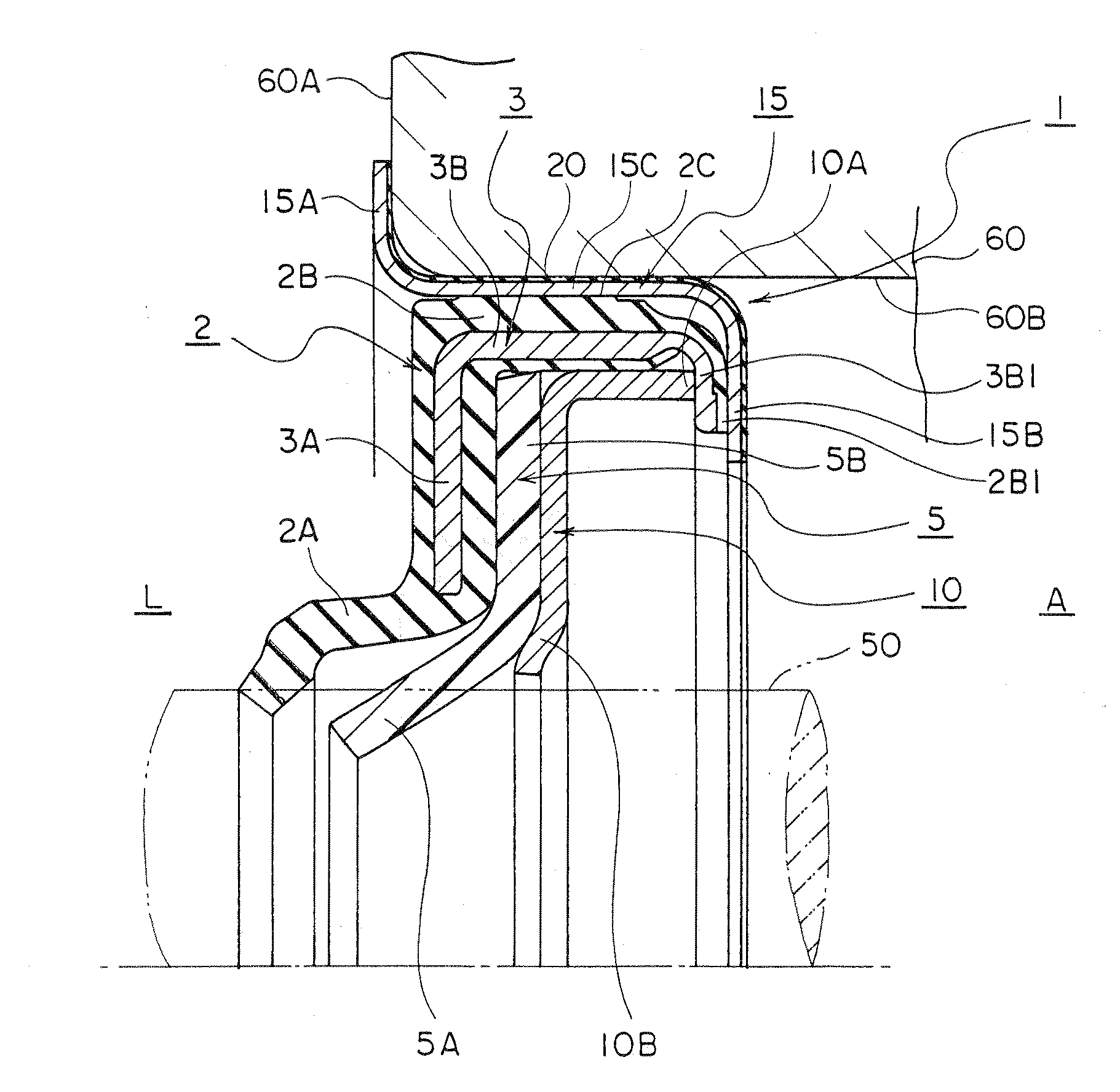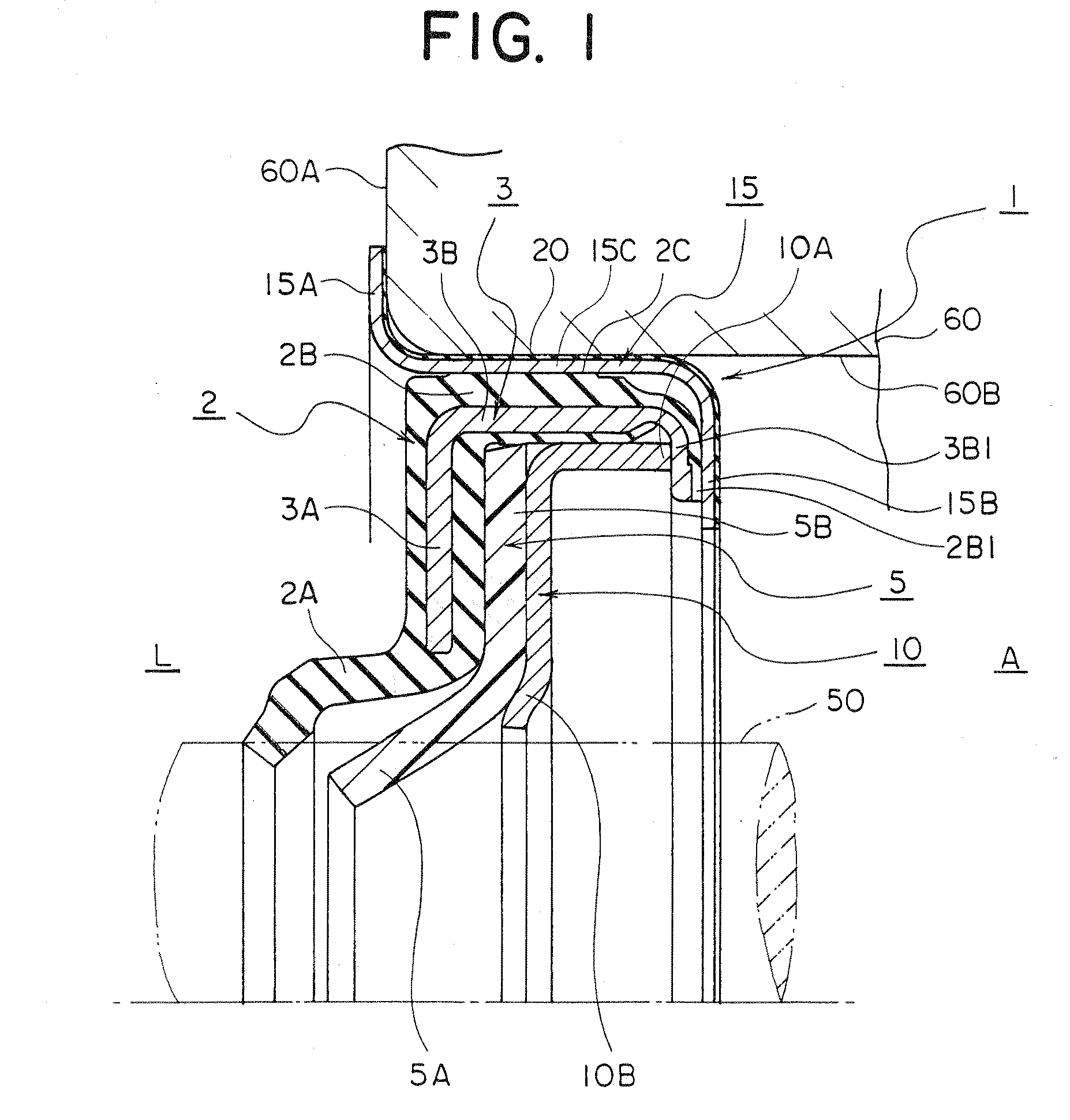Shaft seal apparatus
a shaft seal and seal technology, applied in the direction of engine seals, mechanical devices, engine components, etc., can solve the problems of shaft seal apparatus b>100/b>, inconvenient sealing against high-temperature or high-pressure fluid, and inability to ascertain the accurate retaining of the first sealing portion, etc., to achieve the effect of simple assembly and convenient assembly
- Summary
- Abstract
- Description
- Claims
- Application Information
AI Technical Summary
Benefits of technology
Problems solved by technology
Method used
Image
Examples
embodiment 1
[0056]First, the embodiment 1 of the shaft seal apparatus 1 according to the present invention is explained. FIG. 1 is a half cross-sectional view of the shaft sealing apparatus 1. Also, FIG. 2 is a half cross-sectional view of the shaft sealing apparatus 1 in FIG. 1 contained in a rotary shaft 50. Further explanations refer to FIG. 1 and FIG. 2. The rotary shaft 50 is installed in a bore surface 60B (hereinafter referred to as a bore) disposed in the housing 60. The shaft seal apparatus 1 provides a seal against pressurized fluid which is contained in machine interior L between the bore 60B and the rotary shaft 50. This pressurized fluid, for instance, is cooling water accompanied with temperature and pressure. More specifically, it provides a seal against cooling water for cooling a radiator or the like.
[0057]A first sealing portion 2 is comprised of a fit mount portion 2B of cylindrical tube design, a first sealing lip 2A extending from one end of the fitting portion 2B in radial...
embodiment 2
[0064]Described next is a shaft sealing apparatus 1 as an embodiment 2 according to the present invention. FIG. 3 shows a half cross-sectional view of a shaft sealing apparatus 1 according to the embodiment 2. The case in FIG. 3 also does not dispose a step shoulder portion in the bore 60B of the seal housing 60 for the axial positioning and fixation of the shaft sealing apparatus 1. What makes it different from FIG. 1 is that the joint portion 2B1 and 3B1 of the first sealing portion 2 are disposed in the first engagement portion 15A side in contrast to the joint portion 2B1 and 3B1 of the first sealing portion 2 appeared in FIG. 1. And the cylindrical portion 3B of the reinforcement ring 3 to the second joint portion 3B is formed in a flange-shape in the same direction as the first engagement portion 15A. The joint portions 2B1 and 3B1 of the first sealing portion 2 are constituted by the second joint portion 3B1 of the reinforcement ring 3 and the first joint portion 2B1 which ex...
embodiment 3
[0067]Next described is a shaft seal apparatus 1 of the embodiment 3 according to the present invention. FIG. 4 shows a half cross-sectional view of a shaft sealing apparatus 1 related to the embodiment 3. The case in FIG. 4 also does not dispose a step shoulder portion in the bore 60B of the seal housing 60 for the positioning and fixation of the shaft sealing apparatus 1. What makes it different from FIG. 1 is that it represents a modification example in which the engagement ring (also referred to as a engagement diaphragm) 15 and the reinforcement ring 3 are arranged integrally. This reinforcement ring 3 has almost an identical form with the reinforcement ring 3 shown in FIG. 1. Furthermore, the engagement ring 15 is joined with the reinforcement ring 3 as shown in FIG. 4, and the cylindrical portion 3B of the reinforcement ring 3 is used as the part corresponding to the fitting portion 15C in FIG. 1. That is, the engagement ring 15 has a first engagement portion 15A therein for ...
PUM
 Login to View More
Login to View More Abstract
Description
Claims
Application Information
 Login to View More
Login to View More - R&D Engineer
- R&D Manager
- IP Professional
- Industry Leading Data Capabilities
- Powerful AI technology
- Patent DNA Extraction
Browse by: Latest US Patents, China's latest patents, Technical Efficacy Thesaurus, Application Domain, Technology Topic, Popular Technical Reports.
© 2024 PatSnap. All rights reserved.Legal|Privacy policy|Modern Slavery Act Transparency Statement|Sitemap|About US| Contact US: help@patsnap.com










